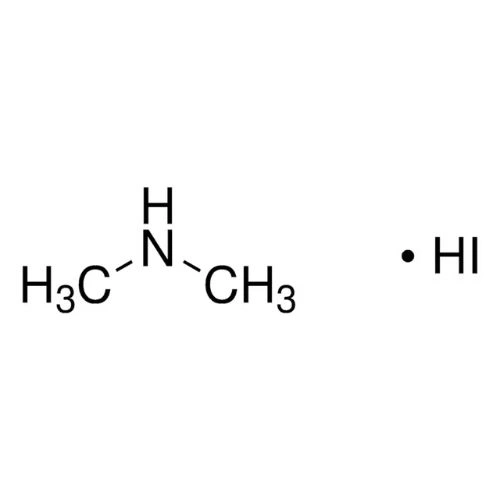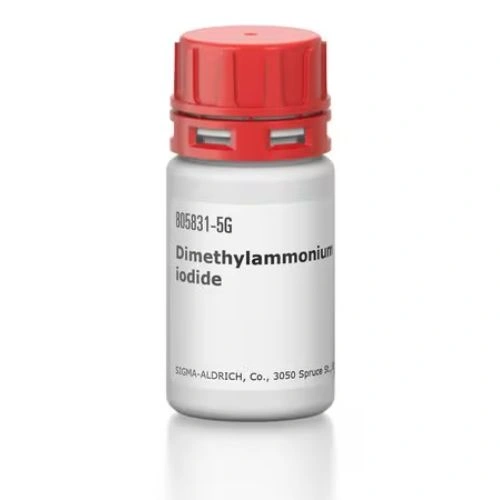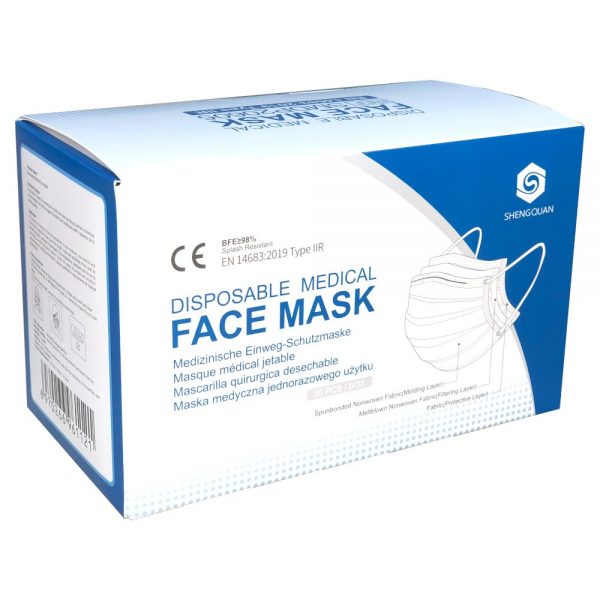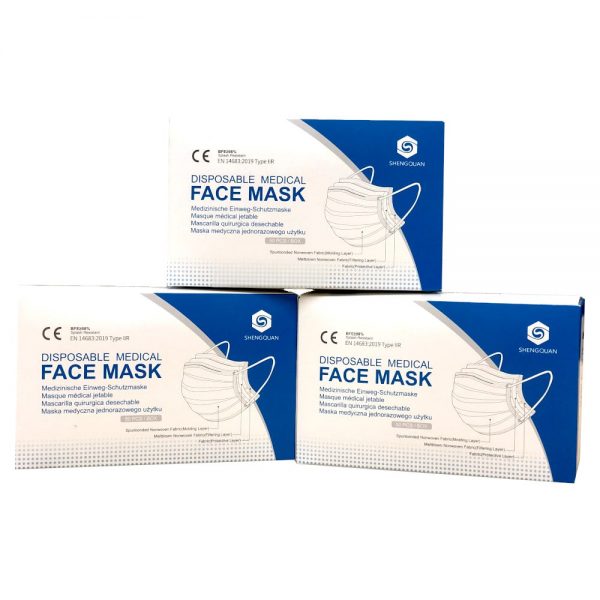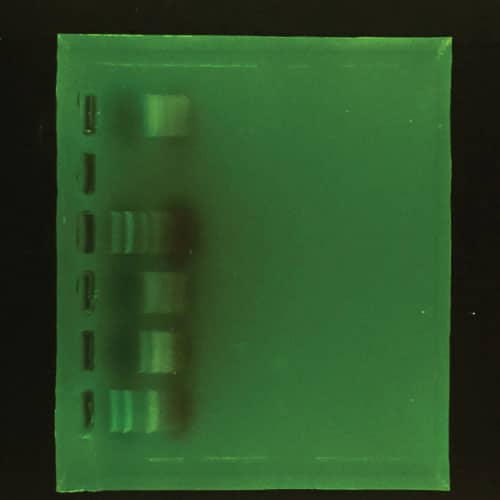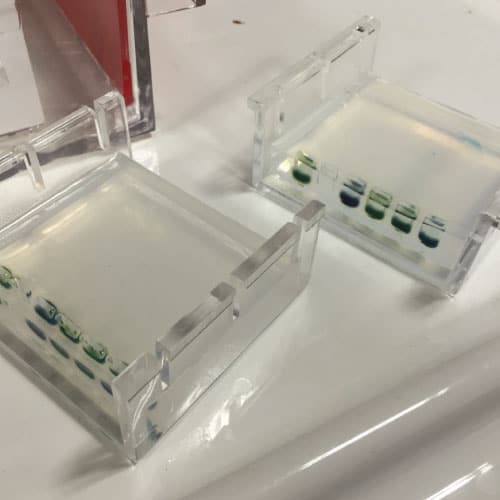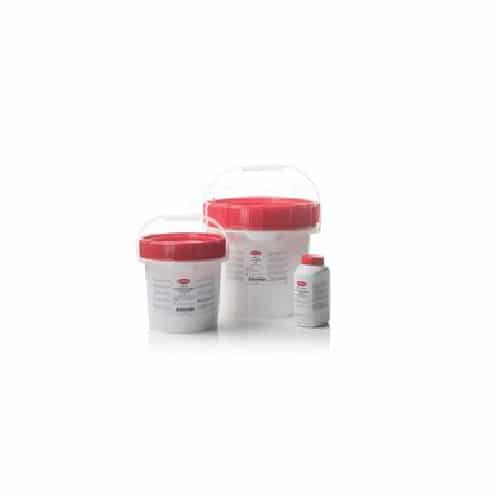
Diagnostic Sensitivity Test Agar 500g
RM1,044.00Brand:
Thermo ScientificTM OxoidTM
Diagnostic Sensitivity Test Agar was developed in Oxoid as a dual purpose medium which would satisfy both diagnostic and susceptibility requirements.
Diagnostic Sensitivity Test Agar, Oxoid Composition
| Typical Formula* | gm/litre |
| Proteose peptone | 10.0 |
| Veal infusion solids | 10.0 |
| Glucose | 2.0 |
| Sodium chloride | 3.0 |
| Disodium phosphate | 2.0 |
| Sodium acetate | 1.0 |
| Adenine sulphate | 0.01 |
| Guanine hydrochloride | 0.01 |
| Uracil | 0.01 |
| Xanthine | 0.01 |
| Aneurine | 0.00002 |
| Agar | 12.0 |
| pH 7.4 + 0.2 @ 25°C |
Diagnostic Sensitivity Test Agar, Oxoid Preparation:
Add 40 g to 1 litre of distilled water. Bring to the boil to dissolve completely. Sterilise by autoclaving at 121°C for 15 minutes.
For blood agar, cool the base to 50°C and add 7% of Defibrinated Horse Blood SR0050. Mix with gentle rotation and pour into Petri dishes (12 ml for a 9 cm dish) or other containers.
RECONSTITUTION AND MIXING SHOULD BE PERFORMED IN A FLASK AT LEAST 2.5 TIMES THE VOLUME OF MEDIUM TO ENSURE ADEQUATE AERATION OF THE BLOOD.
Storage conditions and Shelf life
Store the dehydrated medium at 10-30°C and use before the expiry date on the label.
Store the prepared agar plates at 2-8°C.
Precautions
Diagnostic Sensitivity Test Agar has reduced thymidine activity and this will affect its performance as a primary isolation medium.

Dichloran-Glycerol (DG18) 500g
RM527.00Brand:
Thermo ScientificTM OxoidTM
- Oxoid Dichloran-Glycerol (DG18) Agar Base is a selective low water activity (aw) medium for xerophilic molds from dried and semi-dried foods.
- Also available Chloramphenicol Selective Supplement, Part No. SR0078E and Chloramphenicol Selective Supplement, Part No. SR0078H.
Dichloran-Glycerol (DG18) Agar Base, Oxoid Composition
| Typical Formula* | gm/litre |
| Peptone | 5.0 |
| Glucose | 10.0 |
| Potassium dihydrogen phosphate | 1.0 |
| Magnesium sulphate | 0.5 |
| Dichloran | 0.002 |
| Agar | 15.0 |
| Final pH 5.6 ± 0.2 @ 25°C |
Dichloran-Glycerol (DG18) Agar, Oxoid Preparation:
Suspend 15.75g in 500ml (31.5g/l) of distilled water and heat to dissolve completely. Add 110g per 500ml (220g/l) of Glycerol (Analytical Reagent grade). Reconstitute one vial SR0078E per 500ml medium or one vial SR0078H per 2 litres medium, as directed. Add the vial contents to the DG18 Agar Base. Sterilise by autoclaving at 121°C for 15 minutes. Cool to 50°C, mix well and pour into sterile Petri dishes.
Storage conditions and Shelf life
Store the dehydrated medium at 10-30°C and use before the expiry date on the label.
Store the prepared plates at 2-8°C.
Precautions
The dichloran compound used in this medium is Botran® 2,6-Dichloro-4-Nitro-Analine (CAS: 99-30-9).
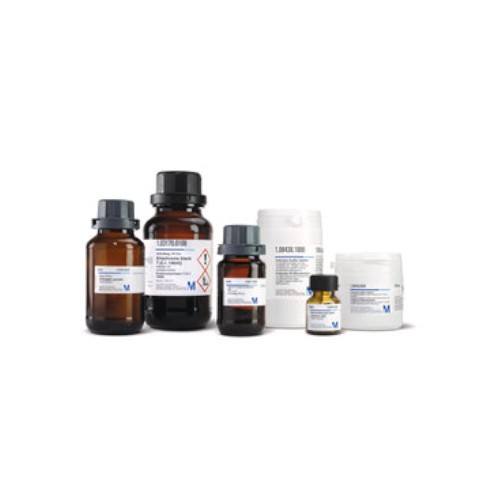
Dichloromethane for analysis EMSURE® ACS,ISO,Reag. Ph Eur (Merck)
Price range: RM89.00 through RM184.00Brand:
Merck
Description
CAS number: 75-09-2
Chemical Formula: CH₂Cl₂
Molar Mass: 84.93 g/mol
Synonyms: Nitric acid ammonia, Ammonia nitrate
EMSURE® grade solvents are suitable for a broad spectrum of classical lab applications and are frequently used in regulated and highly demanding lab applications. EMSURE® provides worldwide best and most extensive product specifications. We declare our EMSURE® range to be in compliance with the ACS, with the reagent part of the European Pharmacopoeia (Reag. Ph Eur) and also with the ISO standards.
Product Specification and MSDS for Dichloromethane EMSURE® (Merck).
Dichloromethane for liquid chromatography LiChrosolv®
RM377.00Brand:
Merck
Description
CAS number: 75-09-2
Chemical Formula: CH₂Cl₂
Molar Mass: 84.93 g/mol
Synonyms: DCM, Methylene chloride, Methylene dichloride
With their high degree of UV transmittance, low particle count, low acidity and alkalinity and low evaporation residue level, LiChrosolv® solvents are ideal for reproducible separations. Since separations are normally carried out under gradient conditions in analytical HPLC, we offer solvents in “gradient grade” as well as “isocratic grade”. This enables to minimize the gradient effect of the solvent involved. Filtered by 0.2 µm filter
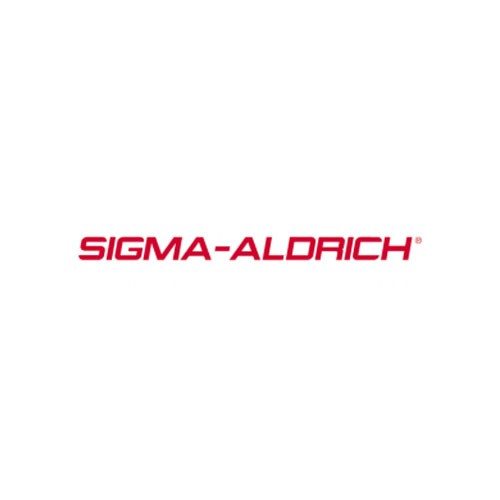
Dichloromethane, HPLC Plus (Sigma-Aldrich)
RM620.00Brand:
Sigma-Aldrich
Description
CAS number: 75-09-2
Chemical Formula: CH2Cl2
Molar Mass: 84.93 g/mol
Synonyms: Methylene chloride, methylene chloride
Application
Suitable for HPLC, GC, spectrophotometry, environmental testing and residue analysis.
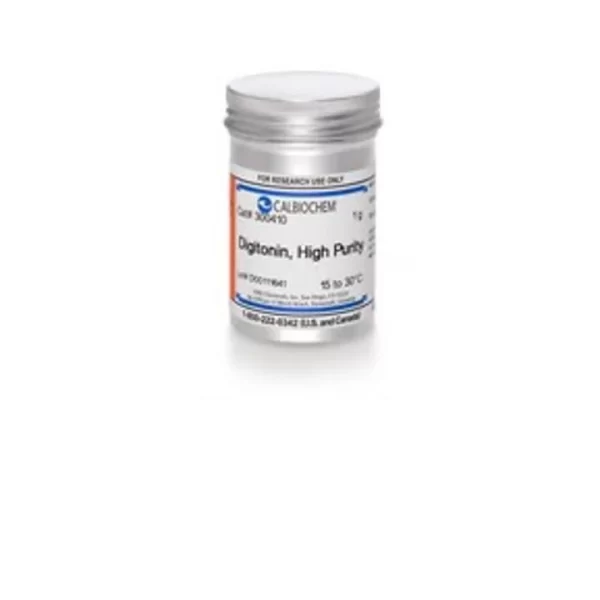
Digitonin, High Purity – CAS 11024-24-1 – Calbiochem (Merck)
RM3,167.00Brand:
Merck
**This product is not currently sold in Malaysia, please contact us for more information
Description:
CAS Number : 11024-24-1
Empirical formula : C56H92O29
A non-ionic detergent commonly used to solubilize membrane-bound proteins.
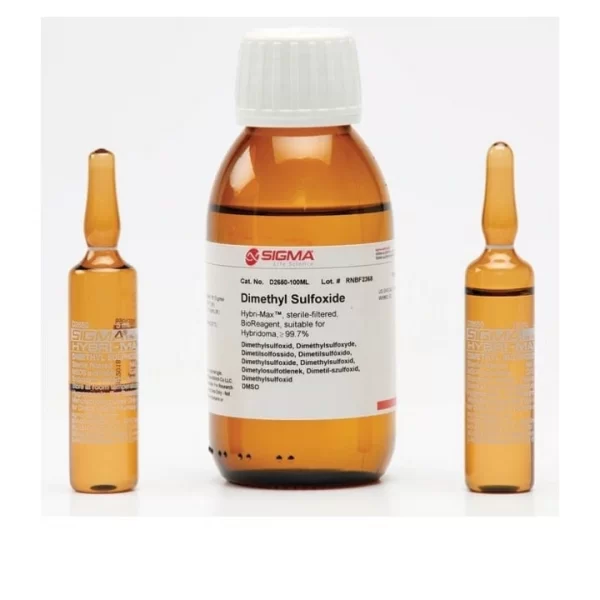
Dimethyl sulfoxide Hybri-Max™, sterile-filtered, BioReagent, suitable for hybridoma, ≥99.7% (Sigma-Aldrich)
RM1,362.00Brand:
Sigma
Description:
CAS Number : 67-68-5
Molecular weight : 78.13 g/mol
Linear formula : (CH3)2SO
Synonyms : DMSO
DMSO is a polar aprotic solvent used in chemical reactions, in polymerase chain reactions (PCR) and as a cryoprotectant vitrification agent for the preservation of cells, tissues and organs. DMSO is used in cell freezing media to protect cells from ice crystal induced mechanical injury. It is used for frozen storage of primary, sub-cultured, and recombinant heteroploid and hybridoma cell lines; embryonic stem cells (ESC), and hematopoietic stem cells. DMSO is frequently used in the combinations with BSA or fetal bovine serum (FBS).

Dimethyl Sulfoxide, Anhydrous, ≥99.9% (Sigma-Aldrich)
Price range: RM582.00 through RM1,688.00Brand:
Sigma-Aldrich
Description
CAS number: 67-68-5
Linear Formula: (CH3)2SO
Molecular Weight 78.13
Synonym: DMSO
General description
Dimethyl Sulfoxide (DMSO) is an apolar protic solvent that is generally used as a reaction medium and reagent in organic reactions.
Application
Dimethyl Sulfoxide may be used as an oxidant for the conversion of isonitriles into isocyanates. DMSO activated by oxalyl chloride can be used in the oxidation of long-chain alcohols to carbonyls.
Dimethylammonium iodide – Sigma-Aldrich
Price range: RM943.00 through RM2,096.00Brand:
Sigma-Aldrich
Synonyms
Dimethylamine hydroiodide, Dimethylammonium iodide
Cas No.
51066-74-1
General description
We are committed to bringing you Greener Alternative Products, which adhere to one or more of The 12 Principles of Greener Chemistry. This product has been enhanced for energy efficiency. Click here for more details.
Application
Dimethylammonium iodide (DMAI) is used as an additive for the fabrication of perovskite-based solar cells. It improves the crystal phases and morphologies of the perovskite films, which affect the power conversion efficiency (PCE) of the optoelectronic devices.[1][2]
The iodide and bromide based alkylated halides find applications as precursors for fabrication of perovskites for photovoltaic applications.[3][4][5]
Legal Information
Product of Greatcell Solar Materials Pty Ltd.Greatcell Solar® is a registered trademark of Greatcell Solar Materials Pty Ltd
Greatcell Solar is a registered trademark of Greatcell Solar

Dimidium bromide, BioReagent, suitable for fluorescence, ~95% (AT), Sigma
RM465.00Brand:
Sigma-Aldrich
CAS number: 518-67-2
Chemical Formula: C20H18BrN3
Molar Mass: 380.28 g/mol
Synonyms: 3,8-Diamino-5-methyl-6-phenylphenanthridinium bromide, Trypadine
Application
Intercalating probe for nucleic acids. Suitable for fluorescence.
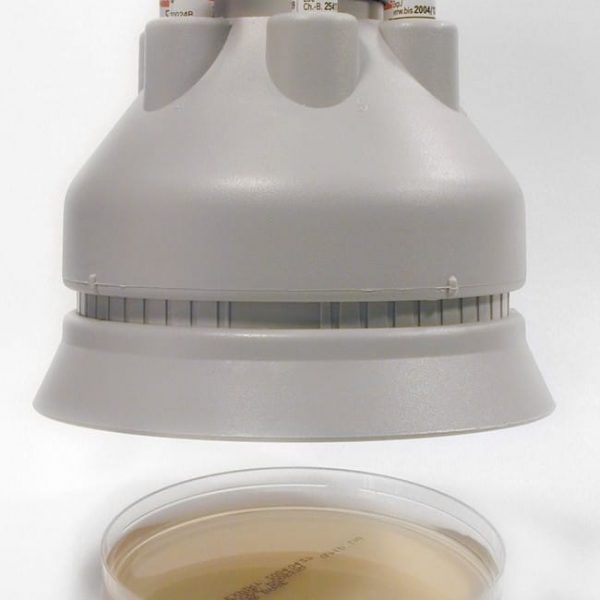
Disk Dispenser 6 Place 100mm Skirt
RM4,113.00Brand:
Thermo ScientificTM OxoidTM
Accurately place antimicrobial susceptibility disks onto your media of choice when carrying out manual Antimicrobial Susceptibility Testing methods using a self-tamping Thermo Scientific™ Oxoid™ Antimicrobial Susceptibility Disk Dispenser.

Disk Dispenser 6 Place 90mm Skirt
RM1,939.00Brand:
Thermo ScientificTM OxoidTM
Accurately place antimicrobial susceptibility disks onto your media of choice when carrying out manual Antimicrobial Susceptibility Testing methods using a self-tamping Thermo Scientific™ Oxoid™ Antimicrobial Susceptibility Disk Dispenser.

Disk Dispenser 8 Place 100mm Skirt
RM4,260.00Brand:
Thermo ScientificTM OxoidTM
Accurately place antimicrobial susceptibility disks onto your media of choice when carrying out manual Antimicrobial Susceptibility Testing methods using a self-tamping Thermo Scientific™ Oxoid™ Antimicrobial Susceptibility Disk Dispenser.

Disk Dispenser 8 Place 90mm Skirt
RM3,287.00Brand:
Thermo ScientificTM OxoidTM
Accurately place antimicrobial susceptibility disks onto your media of choice when carrying out manual Antimicrobial Susceptibility Testing methods using a self-tamping Thermo Scientific™ Oxoid™ Antimicrobial Susceptibility Disk Dispenser.
Disposable Medical Face Mask (Individually Wrapped, 50pcs/box, Ready Stock)
RM0.00Brand:
Buy 10 Free 1! Grab the deal now before the stock runs out!
(Free mask will be included automatically in the shipment once you purchase more than 10 boxes)
Ready Stock! Ship out on the same day after order confirmation!
Features:
- Each Mask is Individually Sealed! No need to worry about the cleanliness of the mask as they are perfectly protected! You can just take it and go!
- 3-ply – Contain Molding, Filtering and Protective Layer
- BFE≥98%
- CE Certified
- Comply with EN 14683:2019 Type IIR
- Splash Resistant
- Comfortable to Wear
- Cover Nose, Mouth and Chin for Full Protection
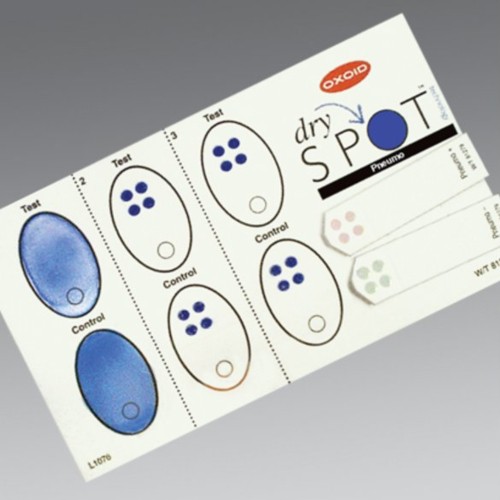
Disposable Reaction Cards 1 x 50 Cards
RM0.00Brand:
Thermo ScientificTM OxoidTM
A latex agglutination test for the identification of streptococcal groups A, B, C, D, F, and G.

DMEM with High Glucose with Glutamine without Sodium Pyruvate 500ml
RM415.00Brand:
Lonza
Product Overview
DMEM is a modification of Basal Medium Eagle (BME) that contains four-times the concentrations of the amino acids and vitamins.
The formulation first contained 1000 mg/L of glucose and was used to culture embryonic mouse cells. DMEM media is suitable for most types of cells, including human, monkey, hamster, rat, mouse, chicken and fish cells.The high glucose version is well suited to high density suspension culture.
Content
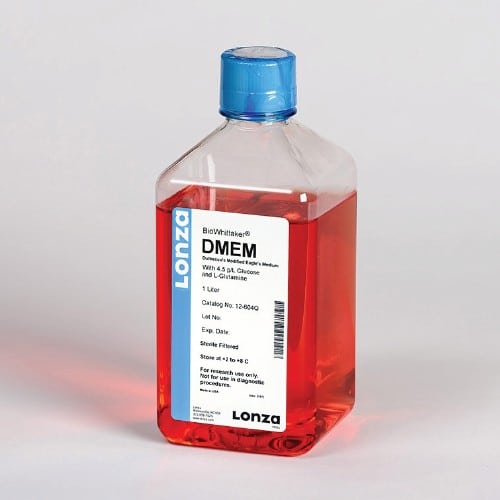
DMEM with High Glucose with L-Glutamine 1L
RM408.00Brand:
Lonza
Product Overview
DMEM is a modification of Basal Medium Eagle (BME) that contains four-times the concentrations of the amino acids and vitamins.
The formulation first contained 1000 mg/L of glucose and was used to culture embryonic mouse cells. DMEM media is suitable for most types of cells, including human, monkey, hamster, rat, mouse, chicken and fish cells. The high glucose version is well suited to high density suspension culture.
Content
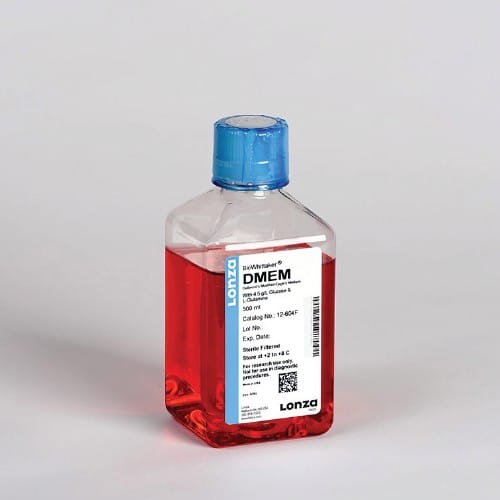
DMEM with High Glucose with L-Glutamine 500ml
RM0.00Brand:
Lonza
** This product has been discontinued.
Product Overview
DMEM is a modification of Basal Medium Eagle (BME) that contains four-times the concentrations of the amino acids and vitamins. The formulation first contained 1000 mg/L of glucose and was used to culture embryonic mouse cells. DMEM media is suitable for most types of cells, including human, monkey, hamster, rat, mouse, chicken and fish cells. The high glucose version is well suited to high density suspension culture.
Content

DMEM with High Glucose with UltraGlutamine 500ml
RM0.00Brand:
Lonza
** This product has been discontinued.
Product Overview
DMEM is a modification of Basal Medium Eagle (BME) that contains four-times the concentrations of the amino acids and vitamins.
The formulation first contained 1000 mg/L of glucose and was used to culture embryonic mouse cells. DMEM media is suitable for most types of cells, including human, monkey, hamster, rat, mouse, chicken and fish cells. The high glucose version is well suited to high density suspension culture.
Content

DMEM with High Glucose without L-Glutamine without Phenol Red 500ml
RM429.00Brand:
Lonza
Product Overview
DMEM is a modification of Basal Medium Eagle (BME) that contains four-times the concentrations of the amino acids and vitamins.
The formulation first contained 1000 mg/L of glucose and was used to culture embryonic mouse cells. DMEM media is suitable for most types of cells, including human, monkey, hamster, rat, mouse, chicken and fish cells.The high glucose version is well suited to high density suspension culture.
Content

DMEM with Low Glucose without L-Glutamine 500ml
RM450.00Brand:
Lonza
Product Overview
DMEM is a modification of Basal Medium Eagle (BME) that contains four-times the concentrations of the amino acids and vitamins. The formulation first contained 1000 mg/L of glucose and was used to culture embryonic mouse cells. DMEM media is suitable for most types of cells, including human, monkey, hamster, rat, mouse, chicken and fish cells.The low glucose formula is used for adherent dependent cells.
Content

DNA Fingerprinting – Electrophoresis Education kit
RM0.00Brand:
Cleaver Scientific
Our DNA fingerprinting kit is the perfect tool to introduce students to the world of electrophoresis and forensic science. DNA fingerprinting is a laboratory technique used to establish a link between biological evidence and a suspect in a criminal investigation. A DNA sample taken from a crime scene is compared with a DNA sample from a suspect. If the two DNA profiles are a match, then the evidence came from that suspect. Conversely, if the two DNA profiles do not match, then the evidence cannot have come from the suspect.
Each kit contains DNA, agarose gel, electrophoresis buffer and DNA stain enough for 8 groups of students to cast and run the experiment and visualise the DNA separation. The gel takes approximately 5 minutes to load, 30 minutes to run and 15 minutes to stain, meaning the whole experiment can be completed in a one hour lesson, with convenient incubation periods for scientific discussion and teaching. Students will solve a crime using an unknown DNA sample from the crime scene and a series of suspects!
Key Features
- Perfect for 1 hour lessons
- Introduce students to DNA and forensic science
- Works perfectly with Cleaver Scientific equipment
DNA Kit
RM0.00Brand:
Cleaver Scientific
This simple kit will enable you to teach the principles behind gel electrophoresis. The kit contains five DNA samples labelled A to E, two of which are identical, with enough reagents to run two sets of six gels. The students will be able to run their own agarose gel and view the DNA after the samples have migrated through the gel. The DNA samples can be viewed on a standard UV transilluminator or using the totally sage blue light LED devices.



